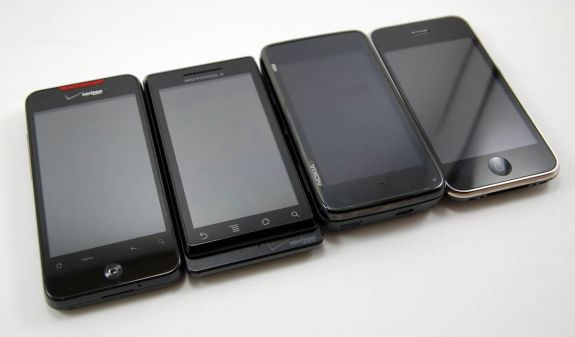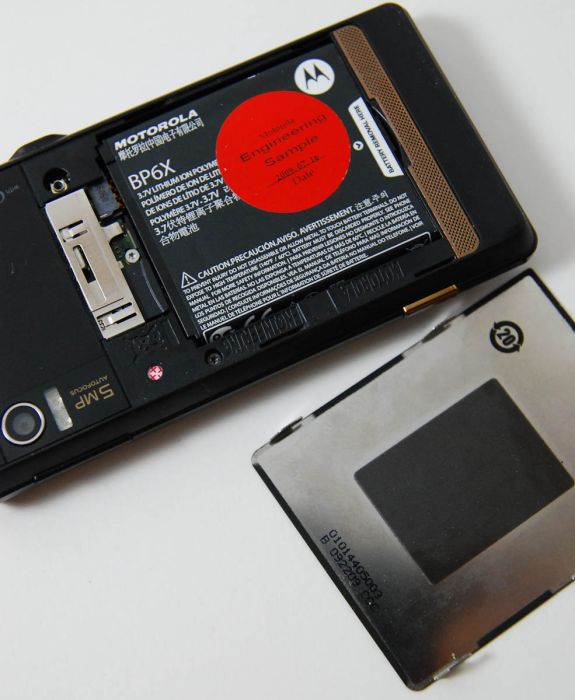Two OMAP 3430 Phones: Nokia N900 and Motorola Droid
by Brian Klug on June 10, 2010 9:29 PM EST- Posted in
- Smartphones
- N900
- Maemo
- Motorola Droid
- Droid
- MeeGo
- Android
- Mobile
It’s impressive Motorola was able to get this right. Previously, only the likes of HTC could get sliding mechanisms to feel just right, yet completely solid. And even then, an occasional slider mechanism would just be errant and misbehave. I remember my HTC Mogul surprising me one day when I slid out the keyboard and it suddenly explosively separated - due to wear on the spring loaded system - sending the display assembly rocketing across a room, ribbon cable flailing behind. I don’t feel like the Motorola Droid would put me through a similar ordeal. It’s solid.
What really set my impression the most though was how snug and firm the battery door feels. Compared to other snap-on plastic battery doors, the Moto Droid’s is perfection. It’s strange how much I’m impressed with it, really, but it’s a surprisingly good microcosm for how good the mechanism is. It’s an honest-to-goodness metal cover that slides and locks onto the back. It doesn’t jiggle when the phone vibrates, and consequently doesn’t make obnoxious noises either. I later learned that all of the Motorola Droid's case is metal, with the exception of a plastic strip where the camera is - for the antennas. Incidentally, right here is also where the phone gets warmest during use.
The only major gripe hardware wise is that the volume rocker on the side feels loose. Searching around online, this seems to be a relatively common complaint, although the volume rocker never missed a button press, it was a bit unnerving. Similarly, the camera button required an impressive amount of force to trigger - usually the only way to know was by feeling for the vibration feedback. In Motorola's defense, this is probably to prevent accidental input in your pocket, but it's a hearty amount of pressure to get that camera app open if you're using the button. Just use the application launcher; really, you'll save scaring yourself.












68 Comments
View All Comments
Wadzii22 - Friday, June 11, 2010 - link
Out of curiosity I ran linpack and Benchmark pi on my droid that's oc'd to 1ghzmy benchmark pi score was 1280 and linpack gives me 17.24 mflops
strikeback03 - Friday, June 11, 2010 - link
Did you run them stock? As those numbers seem to be a ~4x improvement over what is shown here, which seems odd given the ~2x increase in clockspeed.Wadzii22 - Wednesday, June 16, 2010 - link
with the phone completely stock my scores were basically the same as whats in the original article.jamyryals - Friday, June 11, 2010 - link
Please continue this type of in depth comparison with current and future hardware. PC hardware is all well and good, but it's all so fast now the mobile space is a much more interesting battle. Not to mention with how fast things are evolving there is the opportunity for a lot of content.Ratman6161 - Friday, June 11, 2010 - link
For eample, my droid purchased in early April came out of the box running at 600 MHz (though now it actually runs at up to 900 Mhz). My wife got hers in early June and hers is 600 MHz too and also came out of the box with Android 2.1 already on it.Wadzii22 - Friday, June 11, 2010 - link
For whatever reason, setcpu always sees a stock droid's max at 600, but they do run at 550. I just got a new one yesterday after bricking my old droid, it showed the same thing.CharonPDX - Friday, June 11, 2010 - link
Nokia was the originator of the "sell unsubsidized smartphones direct" model, years before Apple or Google. You could get a Nokia N80 at CompUSA completely unlocked for $800 in 2006, a year before the unsubsidized iPhone.Stas - Friday, June 11, 2010 - link
0.1 build with fixed WiFi and maps.LinPack - 12.2 (twelve point two)MFLOPS
Engadget.com loads in 20 sec (default browser)
'nuff said.
Stas - Friday, June 11, 2010 - link
forgot to mention. the CPU is at 800Mhz. I've had it up at 900Mhz with bare Android build (leaked 2.2) and the performance seems no different, but no numbers, sorry.milli - Saturday, June 12, 2010 - link
That's pretty wrong what you're saying there.Qualcomm didn't even license the A8 (nor will they ever).
What they did license is the ARMv7 instruction set (and that's a huge difference). With that they made a custom implementation of the ARMv7 architecture. (BTW Qualcomm already stated in 2005 that they're an architectural licensee for ARM’s ARMv7 instruction set)
There are many differences between Scorpion and A8.
I'll quote from a certain article since i can't say it better:
'Although Scorpion and Cortex-A8 have many similarities, based on the information released by Qualcomm, the two cores differ in a number of interesting ways. For example, while the Scorpion and Cortex-A8 NEON implementations execute the same SIMD-style instructions, Scorpion’s implementation can process128 bits of data in parallel, compared to 64 bits on Cortex-A8. Half of Scorpion’s SIMD data path can be shut down to conserve power. Scorpion’s pipeline is deeper: It has a 13-stage load/store pipeline and two integer pipelines—one of which is 10 stages and can perform simple arithmetic operations (such as adds and subtracts) while the other is 12 stages and can perform both simple and more complex arithmetic, like MACs. Scorpion also has a 23-stage floating-point/SIMD pipeline, and unlike on Cortex-A8, VFPv3 operations are pipelined. Scorpion uses a number of other microarchitectural tweaks that are intended to either boost speed or reduce power consumption. (Scorpion’s architects previously designed low-power, high-performance processors for IBM.) The core supports multiple clock and voltage domains to enable additional power savings."
"Qualcomm claims that Scorpion will have power consumption of roughly 200 mW at 600 MHz (this figure includes leakage current, though its contribution is typically minimal in low-power processes). In comparison, ARM reports on its website that a Cortex-A8 in a 65 nm LP process consumes .59 mW/MHz (excluding leakage), which translates into about 350 mW at 600 MHz."
With that said, i don't understand where the misconception about the Scorpion being an A8 started. Even Qualcomm states clearly on their own website that Scorpion is not licensed from ARM. They also state that they invested hundred of millions in creating their own core based on the ARMv7 instruction set.
I hope now all the staff from Anand will stop saying that there's an A8 inside of Snapdragon. Or maybe you should even clarify that with a small article.